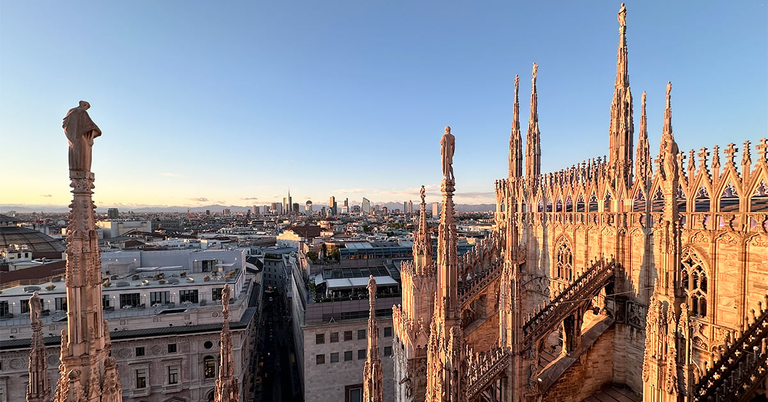
One of the most outstanding and emblematic monuments of Milan is its Cathedral, the Duomo, built in the Gothic style over five centuries, specifically from 1390 when its construction began until the beginning of the 19th century, when it was completed. Its style is Gothic.
It is a cathedral in the centre of the city, and has the distinction of being the second largest Catholic cathedral in the world, after the Cathedral of Seville.
This Cathedral was built in several stages, there were several religious men behind this project, as well as several architects who worked on the construction works, which ended during the Napoleonic occupation of Italy, of the north of Italy.
Officially, the Cathedral was inaugurated in 1965, more than a century after its completion, but with the details already finished.
It is an impressive temple in whose interior we find other works of great importance, such as the Sarcophagus of Archbishop Alberto da Intimiano, or the Sarcophagus of Marco Carelli.
We must also highlight the mausoleum, the works of art that we find, the Renaissance prebisterium, the statue of Pope Martin Vilano, the statue of the Pope of Milan.
The Duomo of Milan is a majestic work of Gothic art that stands in the heart of the Lombard capital and has always been an undisputed icon of Italian architecture and culture.
However, behind its imposing spires and ornate façade lie secrets and curiosities that are often hidden from the view of visitors. So let's discover 10 curiosities you may not have known about Milan's Duomo.
The archaeological excavations under the Duomo.
To unveil the first curiosity about Milan Cathedral, we must take a step back to the times of ancient Rome, when Milan was known as Mediolanum. At that time, two early Christian basilicas and a baptistery stood on the site now occupied by the Duomo: the ancient basilica of Santa Maria Maggiore, the basilica of Santa Tecla and the baptistery of San Giovanni alle Fonti.
The latter, a pioneering example of octagonal architecture in the early Christian era, was the site of the baptism of St. Augustine by St. Ambrose on Easter Eve 397. The remains of the basilica of Santa Tecla and the characteristic octagonal shape of the baptistery still survive in the archaeological section of the cathedral, tangible proof of a glorious and spiritually significant past.
A construction spanning six centuries.
A curiosity about the Milan cathedral is that its construction was extremely long. It is no coincidence, in fact, that the Milanese define ‘being like the Fabbrica del Duomo’ as an undertaking that drags on in time without ever being completed.
This is because the official construction of the cathedral began as early as 1386, but it was only during the 19th century that it was finally completed, thanks to the tireless work of thousands of artists, sculptors and craftsmen from all corners of the world.
Italy's largest organ.

Perhaps not everyone knows that Milan Cathedral houses the largest organ in Italy: located on the high altar, this extraordinary musical instrument has no less than 15,800 pipes and 4 organ cases.
Some of these pipes reach heights of more than 9 metres, while others are so tiny that they measure only a few centimetres. The magnificent surrounding doors are true works of art, painted with scenes from the Old and New Testaments, adding a touch of sacredness and beauty to the already majestic setting of the cathedral.
The signs of the zodiac on the floor.
As soon as you cross the threshold of the imposing cathedral, you will discover a sundial carved into the floor, running the full width of the nave from right to left. Along it are marble tiles carved with the signs of the zodiac.
Looking up towards the vault of the first chapel on the right, there is a small hole in the ceiling which, at solar noon, lets in a ray of light which, depending on the month, illuminates the corresponding sign of the zodiac on the tile below.
This sundial, built as early as 1786 by the astronomers of the Brera Astronomical Observatory, is periodically updated to adapt to the changes brought about by the passage of time, such as the lowering of the floor due to the construction of the metro line that passes under the Duomo.
The nail of the crucifixion.
Another curiosity of the Milan Cathedral has to do with a special nail. In the nave, if you look towards the ceiling of the apse, you can see the tabernacle, 40 metres high, which houses a relic of inestimable value: it is the Holy Nail, one of the nails that, according to tradition, was used during the crucifixion of Christ.
This precious nail is removed from its reliquary and brought to the altar of the Duomo only once a year, in September, during one of the most evocative and mysterious ceremonies of Milanese tradition: the rite of the Nivola. During this ritual, a cloud-shaped ‘lift’ transports the relic, creating a solemn and enveloping atmosphere that envelops the sanctuary.
Saffron in the stained glass windows.
Among the curiosities of the Milan Cathedral that not everyone knows about, there is one that has to do with its majestic and colourful stained glass windows, 52 in total. Not only do they decorate the cathedral, but they also had an educational function: through the biblical representations, even those who could not read could learn the sacred stories.
But there is more: surprisingly, it seems that the recipe for saffron risotto, an emblematic dish of Milanese cuisine, has its origins in the stained glass windows of Milan Cathedral.
Saffron was used to create the yellow stained glass windows, and it is said that the apprentice of the Belgian master glassmaker Valerio da Fiandra, who worked on the stained glass windows of the Duomo, added saffron to the risotto on the occasion of the wedding of the master's daughter, giving rise to an international gastronomic tradition.
The walkable roof.
The terrace of the Duomo di Milano is visited by millions of tourists every year. Climbing the 251 steps or taking a quick lift ride, you can explore the 8000 square metres of terraces, which make the Duomo di Milano the walkable roof of the largest Gothic cathedral in the world.
Among the spires and the thousands of details sculpted in marble, there is one that deserves a special mention: on the spires overlooking the square, on the left edge, two boxers are depicted fighting. These are boxers sculpted in honour of the famous Italian boxer Primo Carnera, celebrating his renowned success in the world of boxing.
The self-cleaning façade.
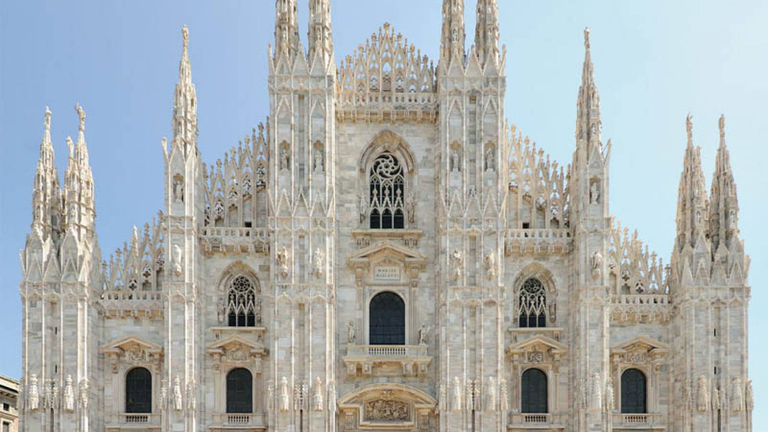
In the first colour photos of Milan's Duomo, the cathedral's façade was almost completely black. In fact, the Piazza Duomo was completely different from what we are used to: all public and private transport could circulate in the area, as pedestrianisation did not come until the end of the 1980s, and so the effects of smog were felt in the cathedral.
However, only in the last ten years has the exterior of the cathedral been covered with a natural material which, thanks to the action of sunlight, is capable of self-cleaning and purifying the air of fine particles.
The Duomo had its own bell tower.
Another curiosity about the Duomo of Milan that not everyone knows is that, in the past, the Gothic cathedral of the Lombard capital also had its own bell tower, located at its peak and probably dating back to the ancient basilica of Santa Maria Maggiore. However, in 1866, for safety reasons, this bell tower was demolished.
Later, the construction of a new bell tower outside the structure was considered. One of the first to propose it was the architect Luca Beltrami, who suggested erecting it near the long sleeve of the Royal Palace (which no longer exists), but the project was never carried out.
The real role of the Madonnina.
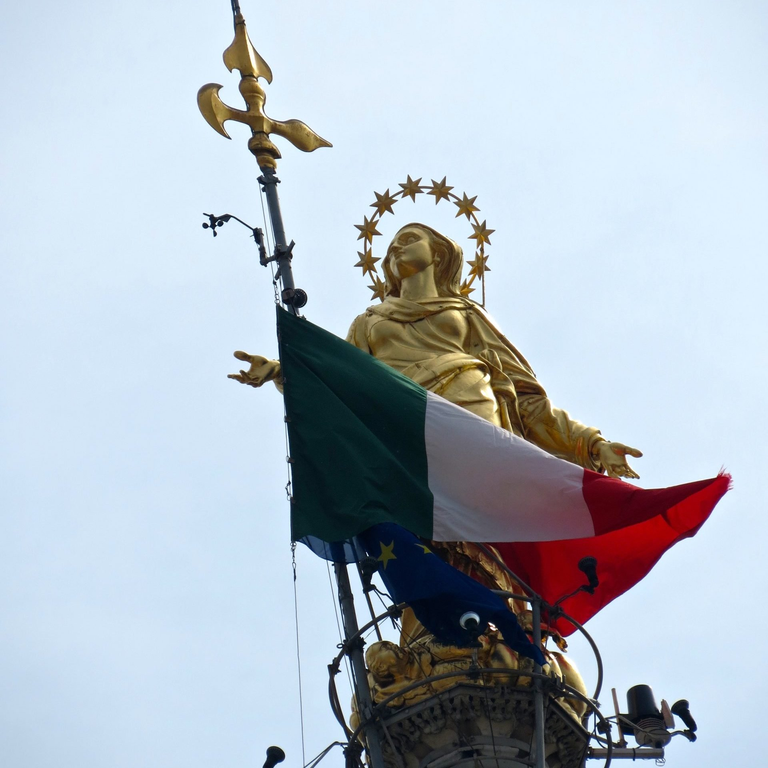
For more than two centuries, the Madonnina has stood majestically on the famous roof of Milan Cathedral, overlooking Piazza del Duomo and the entire city of Milan. At 108.5 metres high, it not only protects the city from evil, but also protects itself from the elements.
Next to the Madonnina stands a halberd-shaped wing, which actually acts as a lightning rod, so the statue is able to defend the cathedral from lightning and inclement weather.

Uno de los monumentos más destacados y emblemáticos de Milán es su Catedral, el Duomo, construida con un estilo gótico a lo largo de cinco siglos, concretamente desde 1390 cuando se comenzó su construcción hasta principios del Siglo XIX, cuando se terminó. Su estilo es gótico.
Se trata de una catedral que encontramos en el centro de la ciudad, y cuenta con la distinción de ser la segunda catedral católica más grande del mundo, después de la Catedral de Sevilla.
Esta Catedral se construyó durante varias etapas, fueron varios los religiosos detrás de este proyecto, así como varios fueron los arquitectos que trabajaron en los trabajos de construcción, que terminaron durante la ocupación napoleónica de Italia, del norte de Italia.
Oficialmente, la Catedral se inauguró en 1965, más de un siglo después de su finalización, pero ya con los detalles terminados.
Es un impresionante templo en cuyo interior encontramos otras obras de una gran importancia, como el Sarcófago del Arzobispo Alberto da Intimiano, o el de Marco Carelli.
También debemos destacar el mausoleo, las obras de arte que encontramos, el prebisterio renacentistas, la estatua del Papa Martín VMilano
El Duomo de Milán es una majestuosa obra de arte gótica que se alza en el corazón de la capital lombarda y que siempre ha sido un icono indiscutible de la arquitectura y la cultura italianas.
Sin embargo, tras sus imponentes agujas y su ornamentada fachada se esconden secretos y curiosidades que a menudo escapan a la vista de los visitantes. Descubramos, pues, 10 curiosidades que quizá no conocía del Duomo de Milán.
Las excavaciones arqueológicas bajo el Duomo.
Para desvelar la primera curiosidad sobre la Catedral de Milán, debemos dar un paso atrás hasta los tiempos de la antigua Roma, cuando Milán era conocida como Mediolanum. En aquella época, dos basílicas paleocristianas y un baptisterio se levantaban en el lugar que hoy ocupa el Duomo: la antigua basílica de Santa Maria Maggiore, la basílica de Santa Tecla y el baptisterio de San Giovanni alle Fonti.
Este último, ejemplo pionero de arquitectura octogonal en la era paleocristiana, fue el lugar del bautismo de San Agustín por San Ambrosio en la víspera de Pascua de 397. Los vestigios de la basílica de Santa Tecla y la característica forma octogonal del baptisterio aún sobreviven en la sección arqueológica de la catedral, prueba tangible de un pasado glorioso y espiritualmente significativo.
Una construcción que abarca seis siglos.
Una curiosidad sobre la catedral de Milán es que su construcción fue extremadamente larga. No es casualidad, de hecho, que los milaneses definan «ser como la Fabbrica del Duomo» como una empresa que se prolonga en el tiempo sin llegar nunca a completarse.
Esto se debe a que la construcción oficial de la catedral comenzó ya en 1386, pero sólo durante el siglo XIX se completó finalmente, gracias al incansable trabajo de miles de artistas, escultores y artesanos de todos los rincones del mundo.
El órgano más grande de Italia.
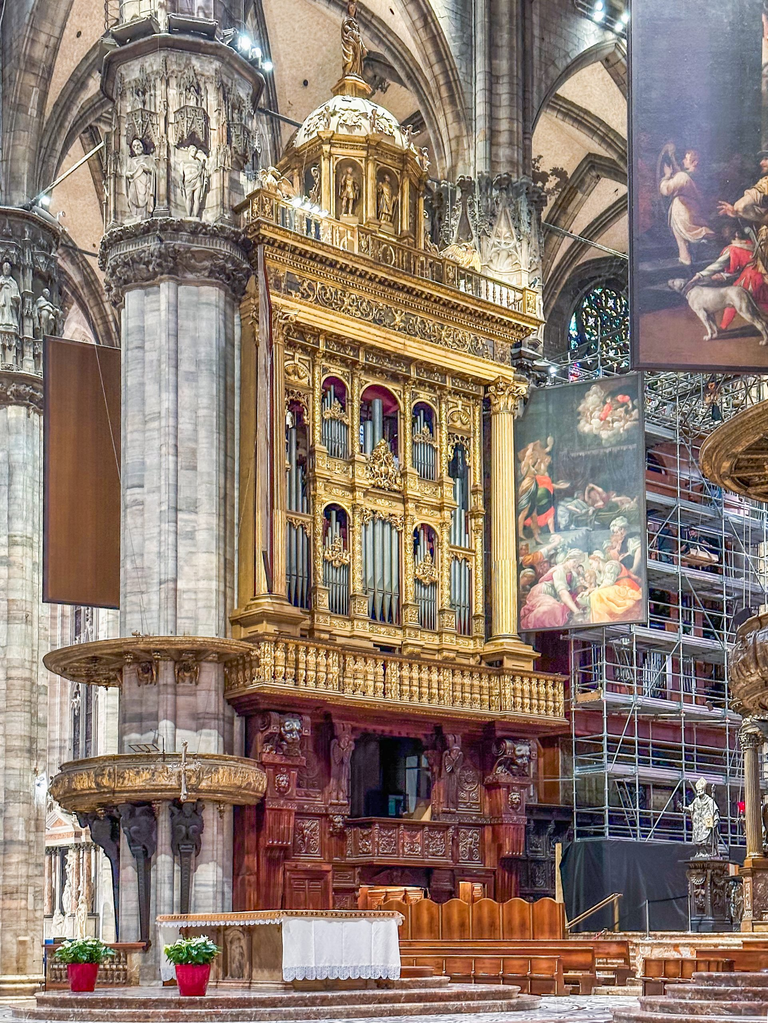
Quizá no todo el mundo sepa que la catedral de Milán alberga el órgano más grande de Italia: situado en el altar mayor, este extraordinario instrumento musical cuenta con nada menos que 15.800 tubos y 4 cajas de órgano.
Algunos de estos tubos alcanzan alturas de más de 9 metros, mientras que otros son tan diminutos que sólo miden unos centímetros. Las magníficas puertas que lo rodean son auténticas obras de arte, pintadas con escenas del Antiguo y del Nuevo Testamento, que añaden un toque de sacralidad y belleza al ya de por sí majestuoso marco de la catedral.
Los signos del zodiaco en el suelo.
Nada más cruzar el umbral de la imponente catedral, se descubre un reloj de sol tallado en el suelo, que recorre toda la anchura de la nave, de derecha a izquierda. A lo largo de él hay baldosas de mármol en las que están tallados los signos del zodiaco.
Mirando hacia arriba, hacia la bóveda de la primera capilla, a la derecha, se ve un pequeño agujero en el techo que, al mediodía solar, deja filtrar un rayo de luz que, según el mes, ilumina el signo del zodiaco correspondiente en el azulejo de abajo.
Este reloj de sol, construido ya en 1786 por los astrónomos del Observatorio Astronómico de Brera, se actualiza periódicamente para adaptarse a los cambios provocados por el paso del tiempo, como el rebajamiento del suelo debido a la construcción de la línea de metro que pasa bajo el Duomo.
El clavo de la crucifixión.
Otra curiosidad de la Catedral de Milán tiene que ver con un clavo especial. En la nave, si se mira hacia el techo del ábside, se puede ver el tabernáculo, a 40 metros de altura, que alberga una reliquia de inestimable valor: se trata del Santo Clavo, uno de los clavos que, según la tradición, se utilizaron durante la crucifixión de Cristo.
Este precioso clavo se extrae de su relicario y se lleva al altar del Duomo sólo una vez al año, en septiembre, durante una de las ceremonias más evocadoras y misteriosas de la tradición milanesa: el rito de la Nivola. Durante este ritual, un «ascensor» en forma de nube transporta la reliquia, creando una atmósfera solemne y envolvente que envuelve el santuario.
Azafrán en las vidrieras.
Entre las curiosidades de la catedral de Milán que no todo el mundo conoce hay una que tiene que ver con sus majestuosas y coloridas vidrieras, 52 en total. No sólo decoran la catedral, sino que también tenían una función educativa: a través de las representaciones bíblicas, incluso quienes no sabían leer podían aprender las historias sagradas.
Pero hay más: sorprendentemente, parece que la receta del risotto al azafrán, plato emblemático de la cocina milanesa, tiene su origen en las vidrieras de la catedral de Milán.
En efecto, el azafrán se utilizaba para crear los vidrios de color amarillo, y se cuenta que el aprendiz del maestro vidriero belga Valerio da Fiandra, encargado de trabajar en las vidrieras del Duomo, añadió azafrán al risotto con motivo de la boda de la hija del maestro, dando origen a una tradición gastronómica internacional.
La azotea transitable.

La terraza del Duomo di Milano es visitada cada año por millones de turistas. Subiendo los 251 escalones o dando un rápido paseo en ascensor, podrá explorar los 8000 metros cuadrados de terrazas, que hacen del Duomo di Milano el techo transitable de la catedral gótica más grande del mundo.
Entre las agujas y los miles de detalles esculpidos en mármol, hay uno que merece una mención especial: en las agujas que dan a la plaza, en el borde izquierdo, se representa a dos boxeadores luchando. Se trata de boxeadores esculpidos en honor al famoso boxeador italiano Primo Carnera, celebrando así su reconocido éxito en el mundo del boxeo.
La fachada autolimpiable.
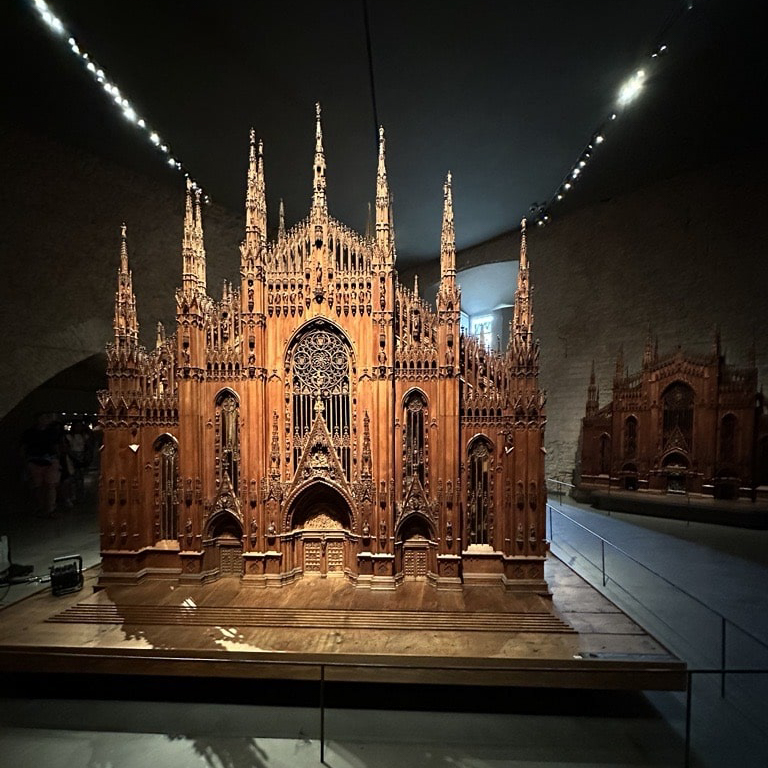
En las primeras fotos en color del Duomo de Milán, la fachada de la catedral era casi completamente negra. De hecho, la Piazza Duomo era totalmente diferente a como estamos acostumbrados: todos los transportes públicos y privados podían circular por la zona, ya que la peatonalización no llegó hasta finales de los años 80, y por eso los efectos del smog se dejaban sentir en la catedral.
Sin embargo, sólo en los últimos diez años se ha cubierto el exterior de la catedral con un material natural que, gracias a la acción de la luz solar, es capaz de autolimpiarse y purificar el aire de partículas finas.
El Duomo tenía su propio campanario.
Otra curiosidad sobre el Duomo de Milán que no todo el mundo conoce es que, antiguamente, la catedral gótica de la capital lombarda también tenía su propio campanario, situado en su cúspide y que probablemente se remontaba a la antigua basílica de Santa Maria Maggiore. Sin embargo, en 1866, por motivos de seguridad, este campanario fue demolido.
Más tarde, se planteó la construcción de un nuevo campanario fuera de la estructura. Uno de los primeros en proponerlo fue el arquitecto Luca Beltrami, que sugirió erigirlo cerca de la manga larga del Palacio Real (que ya no existe), pero el proyecto nunca se llevó a cabo.
El verdadero papel de la Madonnina.
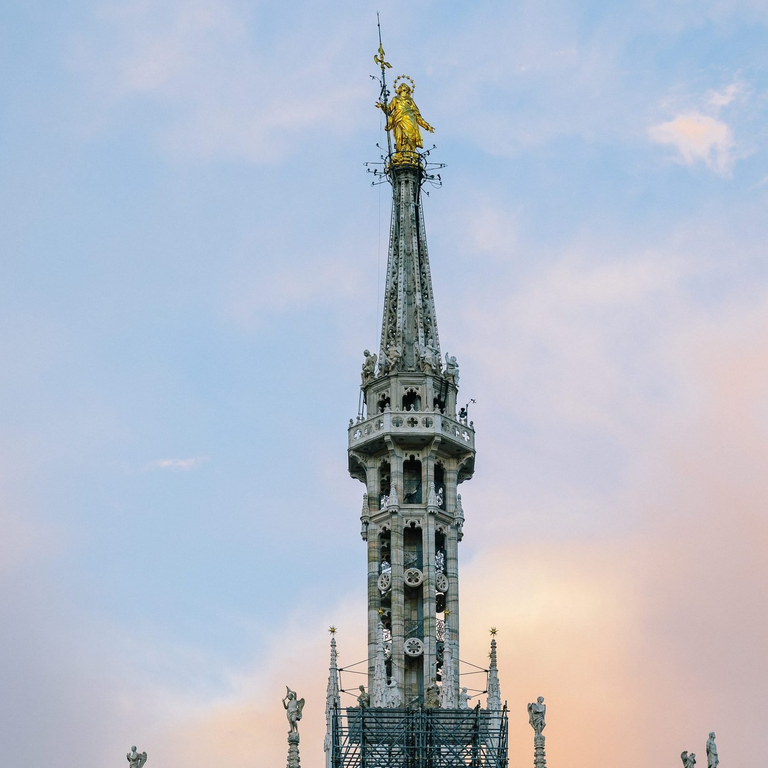
Desde hace más de dos siglos, la Madonnina se alza majestuosa sobre el famoso tejado de la catedral de Milán, vigilando la plaza del Duomo y toda la ciudad de Milán. Con sus 108,5 metros de altura, no sólo protege a la ciudad del mal, sino también a sí misma de los elementos.
Junto a la Madonnina se alza un ala en forma de alabarda, que en realidad hace las veces de pararrayos, por lo que la estatua es capaz de defender la catedral de los rayos y las inclemencias del tiempo.
Source images / Fuente imágenes: Duomo di Milano.


